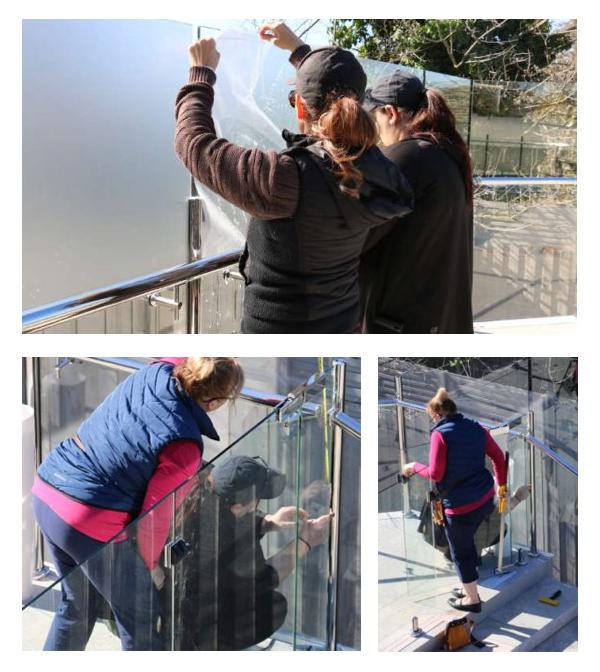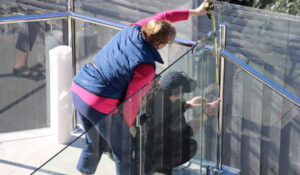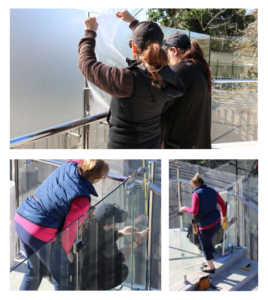Window Frosting vs. Other Privacy Options: What’s the Difference?
Privacy is a crucial aspect of any living or working space. It not only provides a sense of security but also enhances comfort and productivity. When it comes to enhancing privacy in windows, there are various options available, including window frosting, blinds, curtains, tinting, and shutters. In this article, we will explore the key differences between these privacy options and help you make an informed decision for your specific needs.
Window Frosting
Window frosting involves applying a translucent or opaque film to the glass surface of a window. It creates a frosted or etched appearance, obstructing the view from the outside while allowing natural light to pass through. Window frosting can be achieved through various techniques, including adhesive films, sprays, or even sandblasting.
Benefits of Window Frosting
Window frosting offers several advantages as a privacy option. Firstly, it allows ample natural light to enter the room, creating a bright and inviting atmosphere. It also provides privacy during the day, preventing outsiders from seeing inside while maintaining a clear view from the inside. Additionally, window frosting adds an elegant and modern touch to the windows, enhancing the overall aesthetic appeal of the space.
Types of Window Frosting Options
There are different types of window frosting options available, depending on individual preferences and requirements. Some popular choices include:
- Frosted Window Film: This is a self-adhesive film that can be easily applied to the glass surface. It comes in various patterns, designs, and opacity levels, allowing customization according to specific privacy needs.
- Etched Glass Effect Spray: This involves using a spray-on solution that creates a frosted appearance. It is a cost-effective DIY option but may require reapplication over time.
- Decorative Window Films: These films not only offer privacy but also add decorative elements to the glass. They come in a wide range of patterns, colors, and textures, allowing for creativity and personalization.
DIY Window Frosting Techniques
- Adhesive Film Application: This is a simple and cost-effective method where pre-cut adhesive films are applied directly to the window glass. These films are available in various sizes and designs, allowing for easy customization.
- Stenciling: Stenciling involves creating a design or pattern on the window using a stencil template and a frosting spray or cream. The stencil is placed on the glass, and the frosting material is sprayed or applied over it, resulting in a beautiful frosted pattern.
- Vinyl Decals: Vinyl decals are an excellent option for adding decorative elements to your frosted windows. These decals come in various designs, such as flowers, geometric shapes, or even custom designs, and can be easily applied and removed without leaving any residue.
- Window Frosting Sprays: Frosting sprays are available in aerosol cans and can be sprayed directly onto the window glass. They create a frosted effect, similar to etched glass, and can be used to cover the entire window or create patterns and designs.
It’s important to note that while DIY window frosting techniques can be a fun and cost-effective way to enhance privacy, they may require some skill and patience. It’s advisable to follow the instructions provided with the chosen product and take necessary precautions to ensure a successful application.
Window Blinds
Window blinds are another popular option for enhancing privacy in windows. They consist of horizontal or vertical slats that can be adjusted to control the amount of light and privacy required. Blinds are available in various materials, including wood, aluminum, and fabric, offering a wide range of styles and designs.
Types of Window Blinds
- Venetian Blinds: These blinds feature horizontal slats that can be tilted to control light and privacy. They are available in various materials, such as wood, faux wood, or aluminum, and offer a classic and versatile look.
- Vertical Blinds: Vertical blinds consist of vertical slats that can be tilted or drawn to the side. They are often used for larger windows or sliding glass doors and provide excellent light and privacy control.
- Roller Blinds: Roller blinds are made of fabric and can be rolled up or down to adjust privacy and light levels. They come in a variety of colors and patterns, offering both functionality and style.
Pros and Cons of Using Window Blinds for Privacy
Window blinds offer several advantages when it comes to privacy:
– Adjustable Privacy: Blinds provide the flexibility to adjust the slats according to the desired level of privacy, allowing you to control the outside view.
– Light Control: Blinds enable you to regulate the amount of natural light entering the room, creating a comfortable ambiance.
– Style Variety: With a wide range of materials, colors, and designs available, blinds can complement various interior styles and add a touch of sophistication to your windows.
However, it’s important to consider some drawbacks:
– Maintenance: Blinds require regular cleaning to remove dust and debris that can accumulate on the slats. Some materials may be more prone to collecting dust than others.
– Limited Insulation: Blinds provide minimal insulation against heat and cold compared to other options like curtains or window shutters.
– Cord Safety: Blinds with cords may pose a safety risk, especially in households with young children or pets. It’s important to ensure proper cord management or opt for cordless alternatives.
Window Curtains
Window curtains are a classic and versatile privacy option that can add elegance and style to any space. They are made of fabric and hang from a rod or track, allowing easy opening and closing. Curtains offer a wide range of choices in terms of style, color, pattern, and fabric, making them highly customizable.
Explanation of Window Curtains
Window curtains consist of fabric panels that hang from a rod or track, covering the window when closed and allowing for easy opening when desired. They are available in a variety of styles, including sheer curtains, blackout curtains, and decorative curtains, allowing you to choose the option that best suits your privacy and aesthetic preferences.
Different Curtain Styles and Materials
- Sheer Curtains: Sheer curtains are made of lightweight and translucent fabric that allows natural light to pass through while providing a certain level of privacy during the day. They offer a soft and airy look and are often used in combination with other curtains or blinds for layered privacy.
- Blackout Curtains: Blackout curtains are designed to block out light completely and provide maximum privacy. They are made of thick, opaque fabric with a special lining that prevents light from entering the room. Blackout curtains are particularly beneficial for bedrooms, home theaters, or spaces where privacy and light control are paramount.
- Decorative Curtains: Decorative curtains are chosen primarily for their visual appeal. They come in a variety of patterns, colors, and textures, allowing you to add a touch of style and personality to your windows. While they may offer some privacy, their main purpose is to enhance the overall aesthetic of the room.
Advantages and Disadvantages of Using Curtains for Privacy
Curtains offer several benefits as a privacy option:
– Versatility: With a wide range of styles, colors, and patterns available, curtains provide endless possibilities for customization, allowing you to match them with your existing decor and personal style.
– Light Control: Depending on the fabric and lining chosen, curtains can provide various levels of light control. Sheer curtains offer a soft diffusion of natural light, while blackout curtains completely block out light.
– Sound Insulation: Curtains made of thick fabric can also provide some level of sound insulation, reducing outside noise and creating a quieter environment.
However, it’s important to consider a few drawbacks:
– Maintenance: Curtains require regular washing or dry cleaning to keep them clean and fresh. Some fabrics may be more delicate and require special care.
– Limited Insulation: While curtains can provide some insulation against heat and cold, they may not be as effective as other options like window shutters or blinds.
– Potential Dust Accumulation: Like any fabric, curtains may accumulate dust over time, requiring periodic cleaning to maintain their appearance and cleanliness.
Now that we’ve explored window frosting, blinds, and curtains as privacy options, let’s delve into another popular choice: window tinting.
Window Tinting
Window tinting involves applying a thin film to the glass surface of windows, which helps reduce the amount of sunlight and heat entering the space while maintaining privacy. It is commonly used in homes, offices, and vehicles to enhance comfort, protect against harmful UV rays, and provide privacy.
Definition of Window Tinting
Window tinting is a process where a thin, transparent film is applied to the interior or exterior of windows. The film contains special additives that reduce the transmission of heat and light while allowing for visibility from the inside.
Benefits of Window Tinting
Window tinting offers numerous advantages as a privacy option:
- Privacy Protection: Window tinting provides a high level of privacy by making it difficult for outsiders to see inside while maintaining a clear view from the inside. This is particularly beneficial for homes, offices, and vehicles located in busy areas or where privacy is a priority.
- UV Ray Protection: Window tinting films are designed to block a significant amount of harmful UV rays. This helps protect the occupants and the interior of the space from the damaging effects of the sun, such as fading of furniture, flooring, and other items.
- Heat Reduction: Tinted windows can significantly reduce the amount of heat entering a space by blocking a portion of the sun’s infrared radiation. This helps maintain a comfortable indoor temperature, reduces the need for excessive air conditioning, and contributes to energy savings.
- Glare Reduction: Window tinting reduces the amount of glare caused by direct sunlight, making it easier to view screens, read, or perform tasks without discomfort or eyestrain.
Types of Window Tinting Films
There are various types of window tinting films available, offering different levels of privacy, heat rejection, and aesthetics. Some common types include:
- Dyed Window Tinting: This type of film consists of a layer of dye that absorbs sunlight and reduces glare. It provides a basic level of privacy and heat rejection while maintaining good visibility from the inside.
- Metalized Window Tinting: Metalized films contain tiny metallic particles that reflect heat and UV rays. They offer increased heat rejection and provide enhanced privacy by reflecting the view from outside.
- Ceramic Window Tinting: Ceramic films are made using advanced technology that incorporates ceramic particles. These films provide excellent heat rejection, UV protection, and privacy while maintaining a clear view from the inside. They are also known for their durability and resistance to fading.
- Reflective Window Tinting: Reflective films have a mirrored or metallic appearance on the outside, providing maximum privacy during the day. However, they may impede visibility from the inside at night.
Pros and Cons of Window Tinting for Privacy
Window tinting offers several benefits as a privacy option, but it’s essential to consider the following aspects:
Pros:
– Effective Privacy: Window tinting provides a high level of privacy during the day, preventing outsiders from seeing inside while maintaining visibility from the inside.
– Heat Reduction: Tinted windows significantly reduce the amount of heat entering a space, contributing to energy efficiency and creating a more comfortable environment.
– UV Protection: Tinted films block a significant portion of harmful UV rays, protecting the occupants and the interior of the space from sun damage.
Cons:
– Limited Privacy at Night: Window tinting films may not provide the same level of privacy at night when interior lights are on, as visibility can be compromised from the outside.
– Professional Installation: To ensure proper installation and avoid issues such as bubbles or peeling, window tinting is best done by professionals, which may incur additional costs.
– Legal Restrictions: Different regions and countries have regulations regarding the darkness and reflectivity of window tinting. It’s important to familiarize yourself with local laws to ensure compliance.
– Cost: Professional window tinting can be a significant investment, especially for large windows or multiple windows. The cost may vary depending on the type of film chosen and the complexity of the installation.
Window Tinting for Different Window Types
Window tinting is suitable for various window types, including:
- Residential Windows: Tinting can be applied to windows in homes, apartments, and condominiums, providing privacy and energy-saving benefits.
- Commercial Windows: Offices, retail spaces, and commercial buildings can benefit from window tinting for privacy, heat reduction, and UV protection.
- Vehicle Windows: Tinting car windows enhances privacy, reduces heat and glare, and protects the interior and occupants from UV rays.
Window Tinting Maintenance
Proper maintenance ensures the longevity and effectiveness of window tinting:
- Cleaning: Use a mild, non-abrasive cleaning solution and a soft cloth or sponge to clean tinted windows. Avoid using ammonia-based cleaners or abrasive materials that could scratch or damage the film.
- Avoid Sharp Objects: Be cautious when placing or removing objects near tinted windows to prevent scratching or puncturing the film.
- Professional Inspection: Periodically have a professional inspect the tinted windows for any signs of wear, peeling, or damage. They can provide recommendations for repair or replacement if needed.
In conclusion, window tinting is a popular privacy option that offers several benefits, including privacy protection, UV ray reduction, heat rejection, and glare reduction. With different types of films available, it’s important to consider your specific privacy needs, local regulations, and budget when choosing window tinting as a privacy solution.
Now, let’s explore another privacy option: window shutters.
Window Shutters
Window shutters are a versatile and stylish option for enhancing privacy while adding an elegant touch to your windows. Shutters are solid and adjustable coverings that are installed on the interior or exterior of windows. They come in various materials, styles, and configurations, allowing you to customize them to suit your privacy needs and aesthetic preferences.
Types of Window Shutters
- Plantation Shutters: Plantation shutters feature wide louvers or slats that can be adjusted to control the amount of light and privacy. They are usually made of wood or faux wood and offer a classic and timeless look. Plantation shutters are popular for their versatility and ability to complement a variety of interior styles.
- Solid Panel Shutters: Solid panel shutters are made of solid wood panels that completely cover the window when closed. They provide maximum privacy and light blockage and are often used in traditional or rustic-style homes.
- Café Shutters: Café shutters, also known as half-height shutters, cover only the bottom half of the window while leaving the upper portion open. They are a popular choice for rooms where privacy is desired while still allowing ample natural light to enter the space.
- Outdoor Shutters: Outdoor shutters are installed on the exterior of windows and provide privacy and protection from the elements. They can be made of materials like wood, vinyl, or aluminum and are a great option for enhancing privacy in outdoor living spaces or to add a decorative element to the exterior of your home.
Advantages of Window Shutters for Privacy
Window shutters offer several benefits as a privacy option:
- Privacy Control: Shutters provide adjustable louvers or panels that allow you to control the amount of privacy needed. You can adjust the angle of the slats or open and close the panels to let in light while maintaining privacy.
- Light Regulation: With shutters, you can easily regulate the amount of natural light entering the room. Adjusting the slats or panels allows you to create the desired ambiance and control glare.
- Insulation: Shutters provide an additional layer of insulation, helping to keep the room cool in summer and warm in winter. They can reduce energy consumption and contribute to cost savings on heating and cooling bills.
- Aesthetic Appeal: Window shutters add a touch of elegance and sophistication to any space. They come in various styles, finishes, and colors, allowing you to enhance the overall aesthetic of your home while ensuring privacy.
Considerations for Window Shutters
Before choosing window shutters, consider the following:
- Material Selection: Select the material that best suits your needs and budget. Wood shutters offer a natural and classic look but may require more maintenance, while vinyl or composite shutters are more durable and easier to clean.
- Installation: Proper installation is crucial for the functionality and appearance of window shutters. It’s recommended to have them professionally installed to ensure they fit properly and operate smoothly.
- Customization: Window shutters can be customized to fit your specific window dimensions and design preferences. Consider factors such as louvers’ size, panel configuration, and color to achieve the desired look and functionality.
In conclusion, window shutters are a versatile and stylish privacy option that offers control over privacy, light, and insulation. With different types of shutters available, you can choose the one that best matches your interior style and privacy needs. Window shutters not only enhance privacy but also add beauty and value to your home.
Now, let’s address some frequently asked questions (FAQs) related to window privacy options:
FAQs
- Are window frosting, blinds, curtains, and shutters equally effective in providing privacy?
Answer: Each privacy option offers different levels of privacy. Window frosting provides maximum privacy by obscuring the view completely. Blinds offer adjustable privacy depending on their position, while curtains and shutters provide adjustable options as well. The effectiveness of each option depends on personal preference and specific privacy needs.
- Can I combine different privacy options for my windows?
Answer: Absolutely! Many homeowners choose to combine privacy options to achieve their desired level of privacy, light control, and aesthetic appeal. For example, you can pair window frosting with curtains or shutters to enhance privacy during the night.
- How do I choose the right privacy option for my windows?
Answer: Consider factors such as the level of privacy desired, the amount of natural light needed, the overall aesthetic of the room, and your budget. Additionally, evaluate the practicality of each option, such as maintenance requirements and ease of use.
- Do privacy options affect the amount of natural light entering the room?
Answer: Yes, privacy options can affect the amount of natural light entering the room. Window frosting reduces light transmission significantly, while blinds, curtains, and shutters can be adjusted to control the amount of light. Sheer curtains and certain types of window tinting films allow more light to pass through while providing some privacy.
- Are there any privacy options suitable for both residential and commercial spaces?
Answer: Yes, many privacy options, such as blinds, curtains, and window tinting, are suitable for both residential and commercial spaces. The choice depends on the specific requirements and aesthetics of the space.
Conclusion
Choosing the right privacy option for your windows is essential to create a comfortable and secure environment. Whether you opt for window frosting, blinds, curtains, or shutters, each option offers its own set of advantages and considerations. Assess your privacy needs, style preferences, and budget to make an informed decision. Remember to maintain and care for your chosen privacy option to ensure its longevity and effectiveness.
To explore further privacy options or to find the perfect solution for your windows, consult with professionals or experts in the field. Enhancing privacy in your space not only adds comfort but also provides peace of mind.




